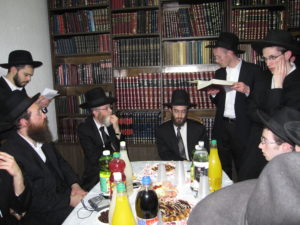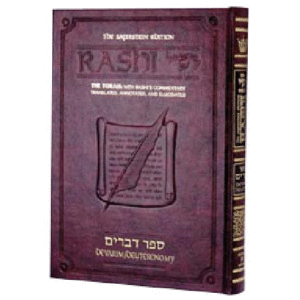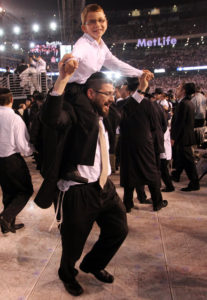Voeschanan 2016 – Anniversary Edition
by devadmin | August 18, 2016 10:21 pm
Siman Tov and Mazel tov……We begin with very exciting and most propitious Tu Bu’Ov and Shabbis Nachamu news: Erica Levitan, she the beautiful and very talented daughter of our long time and close friends Brenda and Larry Levitan, is engaged to Sam Grossman (not related). A big big Mazel tov to Erica and Sam; may they merit to live a long and happy life together. Mazel Tov to Brenda and Larry Levitan, to Larry’ dad, Morton and to his wife Lynn. Mazel tov as well to Brenda’s mom, Sonja, and of course at times of simchas, we remember Brenda’s dad, David Mostel, OBM. Mazel tov as well to Sammy’s parents, Deborah and Elliot Grossman, they of Merrick, New York and to both extended families.
ANNIVERSARY EDITION
The Ever Shrinking Observance of the Nine Days & The Ever Changing Art Scroll: A must read!
Seven years ago this very parsha, late on a Friday afternoon, the future Oisvorfer had just come out of the pool, was already showered and was sitting on the bed relaxing in one of the guest rooms (each occupied) waiting for the heylige Shabbis to arrive. The setting: Dunes Road over in Westhampton Beach. It was our (the eishes chayil and mine) first of many weekend visits to our neighbors and close friends, Terri and Andrew Herenstein, our hosts.
 Back then, kimat everyone carried a Blackberry (at least one) and as was typical, many kept one hand attached to the device. Why? Just in case. Just in case of what? Just in case a joke, text, instant message, or, efsher even a last minute important email would arrive. One taka did. It was from Dr. Avi Winkler, a urogynecologist specializing in female pelvic medicine and surgery, whatever that is, ver veyst, asking for a last minute and quickie devar Torah on the parsha. He and I had met for the very first time one week earlier over in Camp Seneca Lake, (shout out to the shver), where avada nothing but Toirah is discussed. A response was written. It included a short torah thought on parshas Voeschanan, this week’s parsha. It was also Shabbis Nachamu as it is every year; they coincide by design. The short devar was laced with very healthy doses of humor, sarcasm and appropriate sexual innuendo. Who knew then but it was the forerunner of what has become the weekly Oisvorfer parsha review which begins year seven this very week. It all began with one reader over at the Herenstein’s summer home; may they be blessed.
Back then, kimat everyone carried a Blackberry (at least one) and as was typical, many kept one hand attached to the device. Why? Just in case. Just in case of what? Just in case a joke, text, instant message, or, efsher even a last minute important email would arrive. One taka did. It was from Dr. Avi Winkler, a urogynecologist specializing in female pelvic medicine and surgery, whatever that is, ver veyst, asking for a last minute and quickie devar Torah on the parsha. He and I had met for the very first time one week earlier over in Camp Seneca Lake, (shout out to the shver), where avada nothing but Toirah is discussed. A response was written. It included a short torah thought on parshas Voeschanan, this week’s parsha. It was also Shabbis Nachamu as it is every year; they coincide by design. The short devar was laced with very healthy doses of humor, sarcasm and appropriate sexual innuendo. Who knew then but it was the forerunner of what has become the weekly Oisvorfer parsha review which begins year seven this very week. It all began with one reader over at the Herenstein’s summer home; may they be blessed.
Shoin, here we are: We begin year seven with kimat 500,000 readers (all over the world, mamish) and with a robust website, the brainchild of chaver Mike Kogan, which houses the great majority (over 95%) of what has been written over the past six years. As an aside, months after the site went live, Mike, asked why I keep writing ‘if you chap’. Because he grew up devoid of any religious background, and became a ba’al tshuva only in his mid 30’s, he read the word ‘chap’ as in chapstick and had no clue of the yeshiva usage of the word ‘chap’..as in charoset, chaptsem (heard mostly by Chasidim) and the sound made when one clears a throat. Six years later, and after reading and posting the Oisvorfer’s heylige Toirah reviews, he knows more than the Oisvorfer himself!
 Let’s start with givaldige news: Because you either long forgot, or more likely, have transgressed many -if not most- of the Aseres Hadibrois (Ten Commandments) given back in Shemois (Exodus 20), in this week’s parsha of Voeschanan, Moishe, who chapped that the Yiddin of his generation were mistama not much better, will repeat them for you and us. And because kimat 40 years have passed since Revelation on Har Sinai where the RBSO descended in a pillar of smoke and gave the Yiddin the first set, the version found in our parsha differs slightly from the first. Of course it does! Can you repeat verbatim anything you said or heard even a week later? It’s avada the case that when textual differences are found, no matter how slight, many will weigh in on their significance. What the words mean now, what they meant then, which set is more authoritative, and so much more. The bottom line: all that was forbidden in the first set, remains off limits! One cannot chap what is not his, if you chap. You’ve been warned; again!
Let’s start with givaldige news: Because you either long forgot, or more likely, have transgressed many -if not most- of the Aseres Hadibrois (Ten Commandments) given back in Shemois (Exodus 20), in this week’s parsha of Voeschanan, Moishe, who chapped that the Yiddin of his generation were mistama not much better, will repeat them for you and us. And because kimat 40 years have passed since Revelation on Har Sinai where the RBSO descended in a pillar of smoke and gave the Yiddin the first set, the version found in our parsha differs slightly from the first. Of course it does! Can you repeat verbatim anything you said or heard even a week later? It’s avada the case that when textual differences are found, no matter how slight, many will weigh in on their significance. What the words mean now, what they meant then, which set is more authoritative, and so much more. The bottom line: all that was forbidden in the first set, remains off limits! One cannot chap what is not his, if you chap. You’ve been warned; again!
On the other hand, it’s Shabbis Nachamu, so named after the first words of this week’s haftorah. The restrictions of ‘the three weeks’ which included ‘the nine days’ and their own even greater restrictions are over. Permission has been granted to stop mourning; happy days are here again. Meat, which was verboten during the nine days, is back on the menu and all are avada ecstatic. Of course going nine days without meat, of any variety, if you chap, is too long to bare. Then again, the nine days aren’t really nine, are they? Not! Why not? Because in any nine day period we avada have the heylige Shabbis, and avada you all know that on Shabbis, which of course begins Friday night, we are not allowed to mourn, even for the two Botei Mikdash (Temples) which were destroyed. Shabbis is a time of joy and such gladness zicher includes eating a good meal which consist of either chicken, meat or both. At times, other pleasures follow, if you chap, mostly not. The emes then is azoy: the nine days are but really seven days. Are they? Not always. And this year, because Rosh Choidesh Ov fell on a Friday and Tisha Be’Ov on the heylige Shabbis itself, we were able to eat meat last Friday and Shabbis and again this past Friday and Shabbis, on the 9th day of Ov, mamish. And the bottom line: this year, with help from the calendar, the nine days were shrunken down to a manageable five (Sunday-Thursday). Ober, did we observe the shortened five days? We did not!
 Seemingly, even five days without meat is too much to bare for unzer Yiddin, ober what to do? Nu, our rabbis -what a clever bunch- mistama restaurateurs, or efsher friends with, or related to a few, decided that five days without meat, was also efsher too much and such abstention could efsher have a deleterious effect on one’s overall health. They needed a plan, a chap, and came up with one. Shoin: let’s make a siyum (completion ceremony).
Seemingly, even five days without meat is too much to bare for unzer Yiddin, ober what to do? Nu, our rabbis -what a clever bunch- mistama restaurateurs, or efsher friends with, or related to a few, decided that five days without meat, was also efsher too much and such abstention could efsher have a deleterious effect on one’s overall health. They needed a plan, a chap, and came up with one. Shoin: let’s make a siyum (completion ceremony).
Our rabbis declared that if one wants to enjoy a good rib steak or any fleish (meat) product and it’s not Friday night, or Shabbis day, one may -even during the nine days- when we lament the tragic loss of our Temples and other calamities that befell the Yiddin during the Three Weeks and specifically the nine days, simply make or participate in a siyum of a tractate of the heylige Gemora (Talmud). It works azoy: One may begin studying any tractate of the heylige Gemora – 63 to pick from – and arrange it so that its completion (siyum) fortuitously coincides with one of the remaining nine days. Shoin! Ois nine days. Armed with a siyum, the sadness of the day is suspended, and replaced temporarily with gladness. The meat restriction too is suspended. Why? Because when one makes a siyum, one also needs to celebrate. How do Jews celebrate? By eating! And we’re not talking pasta and pizza. The good man who completed learning the tractate faces a new obligation: he must partake in a seudas mitzvah (happy mitzvah meal).
Shoin, let’s chazir (review): Avada when one makes a siyum, one is obligated to also have a collation, we call this a seudas mitzvah. Ober how can one make a decent seuda over pizza, pasta, or even fish? One cannot! Shoin: He must therefore make a festive meal and he must, though mamish in the throes of the nine days, eat meat. Why meat? Because our rabbis also taught us azoy: ‘eyn simcha elo bi’bosor (there is no joy without a good piece of meat). Men avada chap this concept, if you chap. Well, blow me down!
Wait: its gets better, much! Not just may the lone fellow who shvitzzed, hurived (sweated and toiled) and studied the heylige Gemora, eat meat, but all others who have been invited to hear the siyum, and even those who happen to be nearby, and hear a few words of the siyum, may also join in the festivities. But wait: it gets even better. In today’s times, with a very healthy dose of gratitude to the entire Art Scroll organization, the good folks who publish the heylige Gemora in English, and about whom we will have more to say mamish shortly, many more, including a healthy number of oisvorf followers, can also make a siyum.
 Ober, the kasha (question) is azoy: is this siyum making loophole during the nine days kosher and sanctioned by all? Not entirely and let’s see what a few had to say:
Ober, the kasha (question) is azoy: is this siyum making loophole during the nine days kosher and sanctioned by all? Not entirely and let’s see what a few had to say:
Says the Remo (551:10), azoy: at a siyum, one may eat meat and drink wine. This applies even to one who has not studied the material but only participates in the siyum. Who created the siyum and the siyum loophole? Says the heylige Gemora (Shabbis 118b), azoy: Abaya, he most famous for arguing over kimat everything with his buddy Rovo, would pride himself over his practice of holding a celebration for all the rabbis whenever a scholar would complete a tractate. Shoin: if it was good for Abaya and approved by the Remo, it’s seemingly also avada good for us. Case closed? Not yet! Because says the Eliyahu Rabbah (whoever that was), azoy: one should not accelerate his pace of learning, or delay the siyum for this purpose. And taka so says the Mishneh Birurah (73). Ober says the Kaf ha-chayim (161), farkert (opposite): one may indeed accelerate his learning so that it coincides with a siyum (during the nine days) so long as his learning will not be adversely affected efsher by rushing through the materials, or slowing down to get the timing just right. Ober may one make a siyum davka because one is in the mood for meat? Or, may he only make a siyum if his intentions are to add joy to an otherwise somber day? Seemingly we rely on the fact that the siyum maker had good intentions.
It stands to reason that this would depend on the individual’s intent. If his motive is the consumption of meat, then clearly it is inappropriate to specifically chart one’s learning such that he will conduct a siyum during the nine days. If his purpose is to add the joy of Torah to this otherwise somber period, then one may conduct such a siyum.
 Ober says the Mishneh Birura 551, azoy: one should not arrange his time and calendar so that his siyum davka coincides with his conclusion of a tractate during the nine days. Shoin: loophole closing? Ober, should it occur naturally, of course, one should not delay making a siyum, nor from enjoying the seudas mitzvah. How it happens that punkt (specifically) so many all over country and overseas are concluding their studies and making siyums during the nine days, ver veyst. It’s seemingly mamish a ness golui (open miracle). Efsher a man made miracle, ver veyst.
Ober says the Mishneh Birura 551, azoy: one should not arrange his time and calendar so that his siyum davka coincides with his conclusion of a tractate during the nine days. Shoin: loophole closing? Ober, should it occur naturally, of course, one should not delay making a siyum, nor from enjoying the seudas mitzvah. How it happens that punkt (specifically) so many all over country and overseas are concluding their studies and making siyums during the nine days, ver veyst. It’s seemingly mamish a ness golui (open miracle). Efsher a man made miracle, ver veyst.
Said Rav Moshe Feinstein as quoted in Moadey Yeshurun (page 132), azoy: preferably one should not make a siyum after the sixth of Ov. Do people adhere to his suggestion? Siyums are made daily. And says the Oruch Hashulchon (551:28), azoy: given that in our times, we (the Yiddin) do not properly celebrate the Torah (whatever that means), it’s preferable that siyums should not be made during the entire nine days. Do the Yiddin follow this suggestion? Also not! Business is business!
But wait and listen to this most amazing chidush (breakthrough). A chaver who grew up in Baltimore and whose father has been a rebbe in the yeshiva system there for decades mamish, told the Oisvorfer azoy: he was sent to a local restaurant to make a siyum during the nine days. He and all others who gathered for the siyum, celebrated by eating a great meat meal. When done, he left as did many others, maybe all. Was the siyum over? Not! Seemingly the kidusha (holiness) of the siyum seeped, efsher via osmosis, into the walls of the restaurant, and others, who arrived for a later seating were also able to enjoy a sanctioned meat meal. You hear this raboyseyee? The holy words spoken at the siyum mamish permeated the restaurant and were mistama still hovering in the air. And the local rabbis, all very reputable, allowed those who did not hear the siyum, those who went out to eat hours later, to be covered by the very siyum he had made earlier. Gishmak mamish! As an aside, the chaver did mention that his father frowned on the ‘eating without attending the siyum loophole’ enjoyed by many. He did not however stop his son from attending. Shoin, in hyntige modernishe times, one can mistama find a siyum on line and then go out to any restaurant of choice. Shoin, yet another reason the Yiddin should be connected to the Internet.
Shoin, let’s spend a few paragraphs discussing what unfolded this past Friday night. Here we go. What taka took place? The heylige Oisvorfer was presenting a short parsha review on the Book of and parsha of Devorim (Deuteronomy) to his captive audience, if you chap. Included in his remarks was the following statement. Sefer Devorim, is also known as Mishneh Toirah, meaning ‘Second Law’ or ‘Review of the Torah’, so named by our sages and who knew better, because it contains a review or rehash of many mitzvis previously taught and certainly previously given by the RBSO to Moishe. That’s what the Oisvorfer has known for decades: Devorim, while containing new mitzvis for sure, is wholly, or mostly, a repeat of the other good Books. So happens that Rabbi Art Scroll, an Achroin (more recent exegete), writes in his introductory commentary notes to Sefer Devorim, azoy, and we quote directly: “Thus, Deuteronomy is not merely a review of the earlier four Books of the Torah, since “of the just over one hundred laws which are contained in this Book, more than seventy are completely new.”” This from their travel size Chumish: First Impression, May 1998.
Nu, though July 4th and fireworks associated with that day, are in the rear view mirror, there were some Jewish fireworks immediately following the review. As an aside, Jewish fireworks are almost always associated with heated arguments. Said one gentlemen brazenly azoy: Sefer Devorim (the book of Deuteronomy) begins with mitzvah 414 and concludes with mitzvah 613. In other words; it contains not 100 commandments as Rabbi Scroll stated in written form in the Stone Edition of the Chumash. Instead, Devorim contains 200 mitzvis and most of those, are brand new. Well, blow me down. He was ready for a fight.
 Those were big words from a big guy with a big mouth and loud voice. He was adamant. He ranted on for quite a while. The good people at Art Scroll were dead wrong and should be “strangled” for publishing and distributing information that is patently false. He stated emphatically that he was correct; that no lesser a giant than the RambaM (Maimonides) and others agree with him. Shoin: Art Scroll is wrong! Ober, with all the money they raised over the years and with all their editors on payroll, could they be dead wrong?
Those were big words from a big guy with a big mouth and loud voice. He was adamant. He ranted on for quite a while. The good people at Art Scroll were dead wrong and should be “strangled” for publishing and distributing information that is patently false. He stated emphatically that he was correct; that no lesser a giant than the RambaM (Maimonides) and others agree with him. Shoin: Art Scroll is wrong! Ober, with all the money they raised over the years and with all their editors on payroll, could they be dead wrong?
Ober the Oisvorfer has for years been reading that Devorim is mostly a repeat, hence its name Mishneh Toirah meaning a second review. Grada, we all grew up with the word ‘mishneh’ as in lechem mishneh (meaning two chalas side by side) and a few -very- also recall that way back in Shemois (16:22), the RBSO instructed the Yiddin, to collect on Fridays only, a Lechem Mishneh of Munn (a second helping of the Munn food) which avada did not fall on the heylige Shabbis. Moreover, the term Mishneh Toirah is found not once but twice in Sefer Devorim (17:18) where the RBSO instructs future Jewish Kings to write “a copy of this law”, meaning a copy of the heylige Toirah. And if our sages, after learning the heylige book of Devorim decided to also name it Mishneh Toirah, mistama they associated that word with second or a doubling, meaning that Devorim contained many ideas, mitzvis, and history which we were reading for a second time.
Many who write on sefer Devorim have confirmed that Devorim taka contains only some new laws; that the majority are repeats. And the question iz azoy: how do these two concepts reconcile? Who is correct? Is the big guy with a mouth that roars correct? Is Art Scroll correct? And if most of the mitzvis found in Devorim are brand new, never having been spoken, why is Devorim referred to as Mishneh Toirah?
The bottom line: Whether to Book of Devorim contains 100, 199, 200, or 201 mitzvis, ver veyst? And whether it contains 75 new ones as mentioned by many reputable sources, or 150 as insists the big guy who incidentally is the publisher of a book on Mitzvis the Oisvorfer has never seen, ver veyst? Completely wrong he was not, completely right he his likely not, and controversial, very, he zicher is. Ober, what we know for sure is this. Devorim is referred to as Mishneh Toirah, so our sages tell us. Perhaps not because many mitzvis are repeated; efsher davka and instead because Moishe does in the last 36 days of his life (which is all of sefer Devorim) repeat quite a bit of history, the history he was an eye witness to in these last 40 years. And if the RBSO decided to include Moishe’s orations in His heylige Toirah, who are we to argue that we already heard all this? Mistama we can all use the review. Of course we can. Without Devorim, would we ever know that the RBSO allowed His army men, while at war and in the heat of battle, to chap a hot shiksa and have his way with her at least once? We would not. Devorim is great!
When pressed, the big guy with the condescending attitude stated again that the great majority of the mitzvis, at least 150, if not more, are brand new. That the book contains not 100 mitzvis but 200. And if he is correct, and Devorim does contain 200 or so mitzvis, that number would come to kimat 1/3 of the total of 613 contained in the heylige Toirah. And if Devorim taka contains 200 brand new mitzvis, it’s zicher not a repeat. When asked why, if so cocksure of himself, he didn’t contact the good people over at Art Scroll and press his point, he responded that he did just that. And their response? He stated “Art Scroll acknowledged its mistake and told him that a correction would be made. Did they?
On Shabbis, we met again. This time he was armed with a newer version of the Stone Chumish, this one, the 12th impression printed in December 2009. And to the Oisvorfer’s surprise, the language was somewhat different than in the Chumish we quoted from above. In his, the introduction to Sefer Devorim states: “…of the two hundred laws which are contained in this Book, more than seventy are brand new.” Well, blow me down! Though the heylige Toirah was given in 2248 and nothing was added or subtracted (as commanded grada in this week’s parsha), it would appear that between printings, Art Scroll found an additional 100 mitzvis in Sefer Devorim. Was the big guy correct? On Sunday, the Oisvorfer found yet another version of the Stone Chumish, this one printed a few years later; the count was still 200 with “more than seventy completely new.” Other words in the introduction to Devorim were however new. Rabbi Art Scroll keeps insisting that “more than seventy are new.” Ober we have to assume that Rabbi Scroll does not agree with the big guy that 150 are new. Neither does anyone else.
 Shoin, three Stone Chumoshim and three different versions of Rabbi Scroll’s introduction to Devorim. Nu, we will assume that taka there was and efsher still is, some controversy regarding the true number of Mitzvis found in Devorim and how many of those are taka brand new. Why can’t our rabbis agree on a number? Because it’s the Jewish way not to. Shoin. Let’s see what a few had to say.
Shoin, three Stone Chumoshim and three different versions of Rabbi Scroll’s introduction to Devorim. Nu, we will assume that taka there was and efsher still is, some controversy regarding the true number of Mitzvis found in Devorim and how many of those are taka brand new. Why can’t our rabbis agree on a number? Because it’s the Jewish way not to. Shoin. Let’s see what a few had to say.
Says Aish.com, efsher the largest disseminator of Toirah on line, azoy: Devorim contains 199 mitzvis and of those 75 are newly minted. Says Torah.org, another excellent great disseminator of weekly divrey Torah from many sources: “Devorim contains 201 mitzvis. Of those, 75 are new and found only in Devorim.” And says the Jewish Encyclopedia of Maimonides: the Book of Devorim contain 202 mitzvis and of those but 75 are new. Ober says the big guy: Devorim begins with 414 and ends with 613 and over 150 are brand new!
The bottom line: instead of stam loshoin horo, there we were arguing over the RBSO’s heylige Toirah; we were perhaps fulfilling the mitzvah of being ‘ameylim baToirah’ (toiling over the words of the heylige Toirah). The bad mouthing came only after Shabbis and all week as the Oisvorfer repeated the argument (not the first) to a few others.
Following the mitzvah count battle, did we kiss and make up? Not. We agreed to disagree. We will both agree that kissing has its place. It does so in this week’s parsha wherein we find (Devorim 6:4 – 6:9) and are introduced to the ‘Shema Yisroel’ prayer, along with the first paragraph of the Shema. The mitzvah of Tifilin and the Mizuzah are both mentioned. Soon we will come across the last paragraph, the commandment to make Tzitzis and place them on our four-cornered garments. We will zicher agree that it ‘s quite ok to kiss our tzitzis, tifilin (at the appropriate times), and the Mizuzah.
A gittin Shabbis-
The Oisvorfer Ruv
Yitz Grossman
Source URL: https://oisvorfer.com/voeschanan-2016-anniversary-edition/
